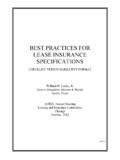Transcription of Planning, Drafting and Implementing Capital Call Provisions
1 The University of Texas School of Law Continuing Legal Education 512-475-6700 Presented: Partnerships, Limited Partnerships and LLCs July 23-24, 2009 Austin, TX planning , Drafting and Implementing Capital call Provisions Cliff Ernst Author contact information: Cliff Ernst Graves Dougherty Hearon & Moody, A Professional Corporation 401 Congress Avenue, Suite 2200 Austin.
2 Texas 78701 512-480-5672 planning , Drafting and Implementing Capital call Provisions Table of Contents Page I. Introduction .. 1 II. Capital Formation for Unincorporated Entities Compared to Corporations .. 2 A. Corporations .. 2 B. Partnerships and Limited Liability Companies .. 3 III. Applicable Provisions of the Texas Business Organizations Code.
3 4 A. Regarding Partnerships Generally .. 4 B. Regarding Limited Partnerships .. 5 C. Regarding Limited Liability Companies .. 6 IV. Loan Versus Capital Contribution .. 7 V. Capital Contribution Provisions and Related Issues .. 7 A. Initial Contributions in Cash .. 8 B. Limiting Additional Contributions .. 8 C. No Limitations on Additional Capital Contributions .. 10 D. Contributions of Personal Property (Other than Cash) .. 10 E. Contributions of Real Estate .. 11 F. Valuing a Non-Cash Contribution .. 13 G. Certain Tax 13 H.
4 Multiple Capital Calls .. 15 ii I. Case 20 VI. Consequences of Failure to 23 A. Loan from the Other Owners .. 23 B. Reduction in Percentage Interest .. 25 C. Sale or Redemption at Appraised Value .. 28 D. 30 E. Subordination .. 32 F. Other 37 VII. Conclusion .. 37 Schedule A Form of Assignment and Bill of Sale Schedule B Form of Warranty Deed planning , Drafting and Implementing Capital call Provisions Cliff Ernst Graves Dougherty Hearon & Moody, A Professional Corporation Austin, Texas I.
5 Introduction. At the heart of almost every transaction involving the formation of a new entity are these questions: Who will invest in the entity? How much will they invest? When will they invest? If the entity being formed is an unincorporated entity (a partnership or a limited liability company), then the lawyer or lawyers representing the organizers of the entity will be required to negotiate and draft Provisions in the company agreement for a limited liability company or the partnership agreement for a partnership that clearly spell out the rights and obligations of the parties regarding these questions.
6 These Provisions are usually referred to as Capital contribution or Capital call Provisions . This outline will begin by focusing on issues related to planning , negotiating and Drafting Capital contribution Provisions . If the parties anticipate that the transaction will involve future investments in the entity by some or all of the parties--in other words not all of the funding is paid upon the formation--then there is at least one more question that needs to be addressed by the parties and their counsel: What happens if a party doesn t make an investment that it agreed to make?
7 The statutes don t answer this question. They authorize the parties and their lawyers to agree to a wide range of Provisions offering a wide range of answers to this question. In fact the answer to this question may be limited only by the creativity of the lawyers and the willingness of the parties to agree to the proposed remedies. Texas cases on this topic will be examined and analyzed and several Drafting examples will be provided. Unless noted otherwise, the sample contract language presented in this outline has been adapted for use in both limited liability company and partnership agreements.
8 According to the 2 so-called check-the-box rules under the Internal Revenue Code of 1986, as amended (the IRC ), limited liability companies with more than one member are automatically classified as partnerships unless the Company elects to be classified as a corporation1 (which is relatively rare).2 For purposes of all discussions and sample contract language contained in this outline, it has been assumed that limited liability companies will be classified as partnerships. The author wishes to acknowledge and thank his partners and fellow practitioners (including opposing counsel in some instances) who provided him with the examples of Capital contribution Provisions that provided a basis for the sample Provisions included in this outline.
9 The sample Provisions included should not be considered forms to be completed by filling in the blanks. Drafters should be certain that any agreement used by them is appropriate for the particular transaction. The presence or absence of a particular term in these sample Provisions should not be taken as an indication that the provision is or is not market standard . II. Capital Formation for Unincorporated Entities Compared to Corporations. One of the fundamental principals often quoted by legal scholars in detailing the differences between corporations and partnerships (and by analogy limited liability companies) is that corporations are creatures of statute and partnerships are creatures of contract.
10 While this fundamental difference has many implications and affects the business law practitioner in many ways, perhaps one of the areas of greatest impact is Capital formation planning for, Drafting for and Implementing the financial investment the owners make in a business entity. A. Corporations. The Texas Business Organizations Code3 (the TBOC ) provides the framework, or the play book, for Capital formation by corporations. Corporations raise Capital by issuing Shares are sold by the corporation to investors for consideration determined according to the rules stated in the TBOC,5 most typically for a purchase price set by the board of directors of the Corporate shares may have a par value or may be without par value.




